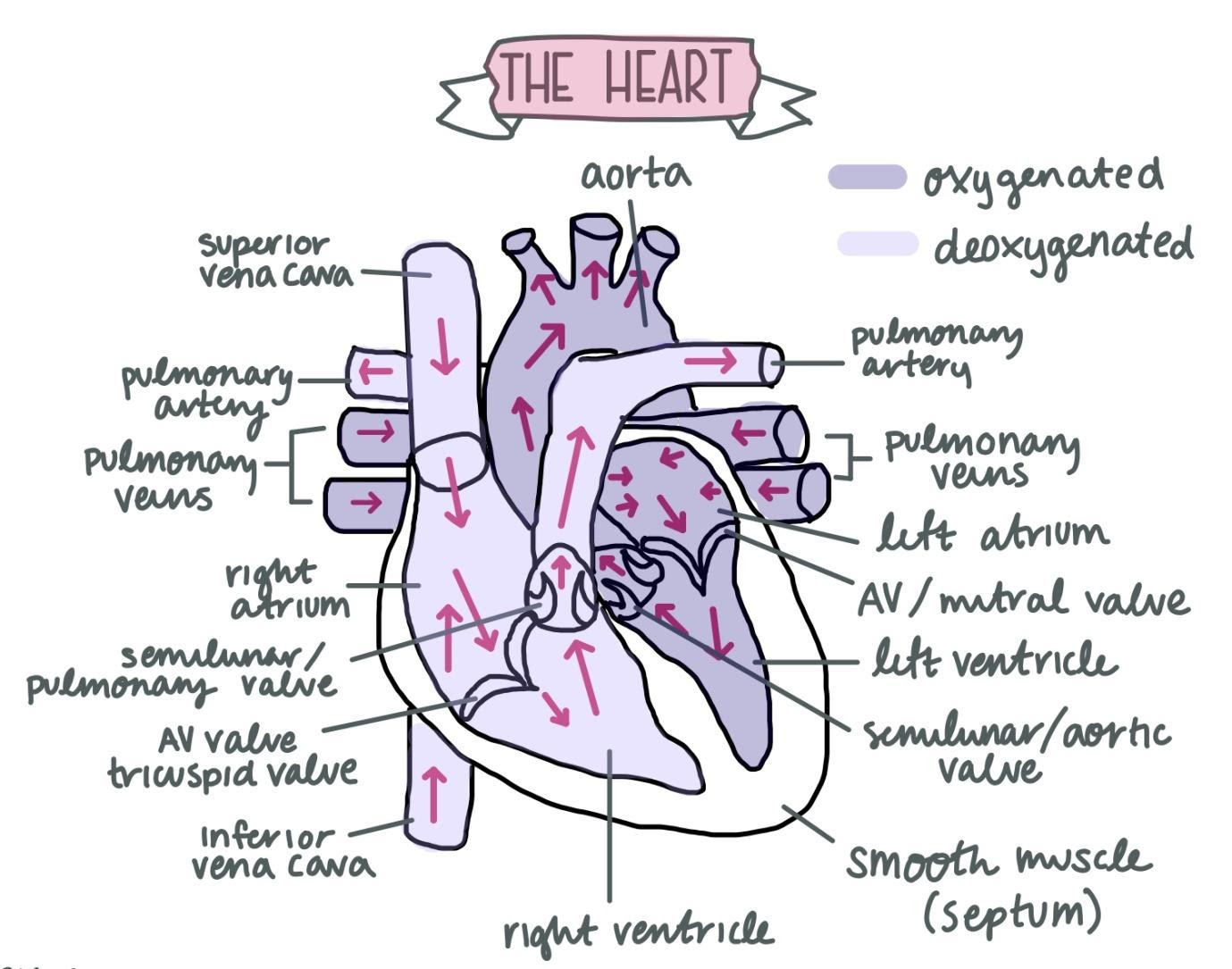
Describe the function of the heart.
Answer
414.6k+ views
Hint: In most animals, the heart is a muscular organ that pumps blood through the circulatory system's blood vessels. The pumped blood transports oxygen and nutrients to the body, as well as metabolic waste like carbon dioxide, to the lungs.
Complete answer:
The human heart is the body's most vital organ. The heart is a vital organ in our bodies. The heart is in charge of our body's major functions and transportation.
The heart is a pumping organ that circulates blood around the body. The human circulatory system is in charge of transporting materials throughout the body. The heart, arteries, veins, and capillaries are the organs of the circulatory system.
There are four chambers in total:
Atria is a term that refers to an (upper chambers)
Ventricles are the organs of the heart (lower chambers)
Heart's layers- There are three layers to the heart's wall:
1. Epicardium: a connective tissue-based protective layer.
2. Myocardium: The heart muscles are formed by the myocardium layer.
3. Endocardium: The valves and the heart are protected by the endocardium, which is the innermost layer.
The Heart's Function- The heart is responsible for blood circulation and the overall health of the body's mechanisms. It is the human body's most important organ.
The heart is responsible for the following vital functions:
The heart's main job is to circulate blood throughout the body.
It transports oxygen and nutrients to the tissues while also removing carbon dioxide and waste from the bloodstream.
It also aids in the maintenance of normal blood pressure levels throughout the body.
The following are how the heart works:
1. The arteries transport oxygenated blood from the heart to the rest of the body. The veins, on the other hand, transport deoxygenated blood from all parts of the body to the heart for oxygenation.
2. Blood is pumped to the right ventricle from the right atrium, which receives it from the veins.
3. The right ventricle is responsible for transporting blood from the right atrium to the lungs.
4. The left atrium receives and pumps oxygenated blood from the lungs to the left ventricle.
5. The oxygenated blood is pumped throughout the body by the left ventricle.

Note:
Cardiovascular diseases are often symptomless, but they can cause chest pain and shortness of breath. The diagnosis of heart disease is frequently made by taking a medical history, listening to heart sounds with a stethoscope, performing an ECG, and using ultrasound. Cardiologists are specialists who specialize in heart diseases, though many other medical specialties may be involved in treatment.
Complete answer:
The human heart is the body's most vital organ. The heart is a vital organ in our bodies. The heart is in charge of our body's major functions and transportation.
The heart is a pumping organ that circulates blood around the body. The human circulatory system is in charge of transporting materials throughout the body. The heart, arteries, veins, and capillaries are the organs of the circulatory system.
There are four chambers in total:
Atria is a term that refers to an (upper chambers)
Ventricles are the organs of the heart (lower chambers)
Heart's layers- There are three layers to the heart's wall:
1. Epicardium: a connective tissue-based protective layer.
2. Myocardium: The heart muscles are formed by the myocardium layer.
3. Endocardium: The valves and the heart are protected by the endocardium, which is the innermost layer.
The Heart's Function- The heart is responsible for blood circulation and the overall health of the body's mechanisms. It is the human body's most important organ.
The heart is responsible for the following vital functions:
The heart's main job is to circulate blood throughout the body.
It transports oxygen and nutrients to the tissues while also removing carbon dioxide and waste from the bloodstream.
It also aids in the maintenance of normal blood pressure levels throughout the body.
The following are how the heart works:
1. The arteries transport oxygenated blood from the heart to the rest of the body. The veins, on the other hand, transport deoxygenated blood from all parts of the body to the heart for oxygenation.
2. Blood is pumped to the right ventricle from the right atrium, which receives it from the veins.
3. The right ventricle is responsible for transporting blood from the right atrium to the lungs.
4. The left atrium receives and pumps oxygenated blood from the lungs to the left ventricle.
5. The oxygenated blood is pumped throughout the body by the left ventricle.

Note:
Cardiovascular diseases are often symptomless, but they can cause chest pain and shortness of breath. The diagnosis of heart disease is frequently made by taking a medical history, listening to heart sounds with a stethoscope, performing an ECG, and using ultrasound. Cardiologists are specialists who specialize in heart diseases, though many other medical specialties may be involved in treatment.
Recently Updated Pages
Express the following as a fraction and simplify a class 7 maths CBSE

The length and width of a rectangle are in ratio of class 7 maths CBSE

The ratio of the income to the expenditure of a family class 7 maths CBSE

How do you write 025 million in scientific notatio class 7 maths CBSE

How do you convert 295 meters per second to kilometers class 7 maths CBSE

Write the following in Roman numerals 25819 class 7 maths CBSE

Trending doubts
State and prove Bernoullis theorem class 11 physics CBSE

What are Quantum numbers Explain the quantum number class 11 chemistry CBSE

Write the differences between monocot plants and dicot class 11 biology CBSE

1 ton equals to A 100 kg B 1000 kg C 10 kg D 10000 class 11 physics CBSE

State the laws of reflection of light

In northern hemisphere 21st March is called as A Vernal class 11 social science CBSE




